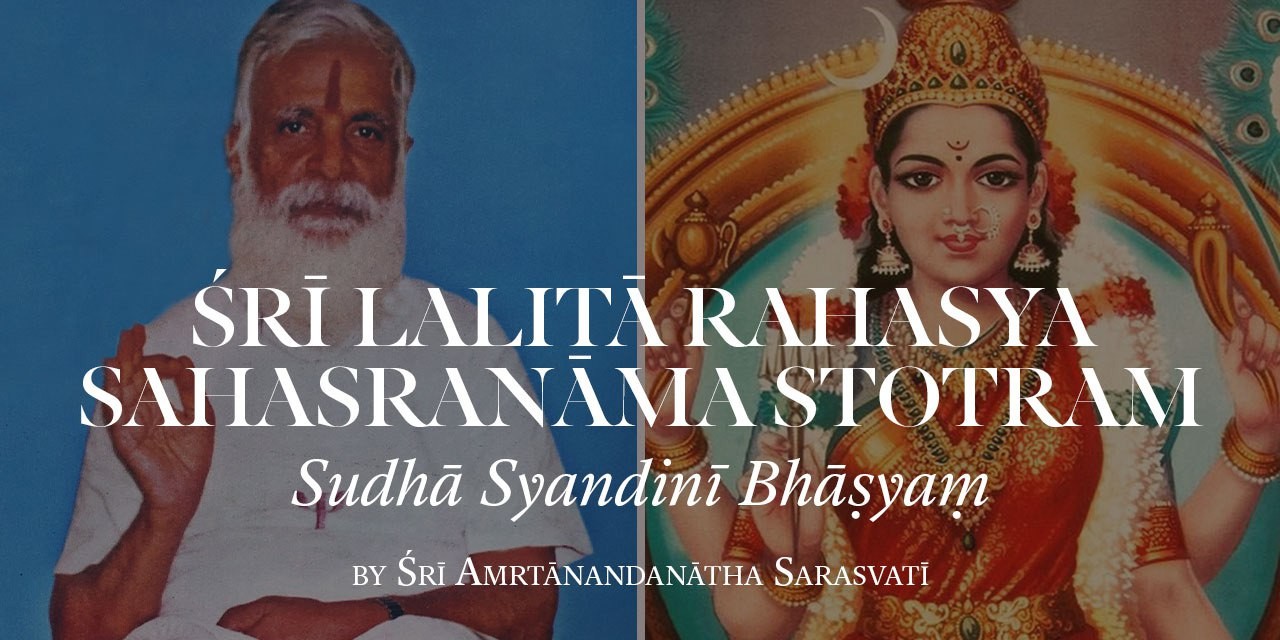
99. Mūlādhāraikanilayā
She resides in the fundamental basis for the manifestation of this entire world.
The location of Mūlādhāra is at the cervix in the female and the bottom tip of the spinal cord in the male. Devi resides at the Mūlādhāra as energy, coiled three and a half times surrounding the svayambhū liṅga. She represents the sexual energy. Imagine a husband and wife in union. The yoni clasps the liṅga like a hand clasping the liṅga. In such a situation, the index finger, the middle finger and ring finger can go completely around the liṅga while a little finger can go only half around. Thus three and a half coils are made. This Kuṇḍalinī is compared to a snake called the Serpent Power. After the one and half coils of the body of the snake Kuṇḍalinī, hood of the Kuṇḍalinī is the thumb going to the top of a liṅga and closing the mouth of the liṅga. So the symbolism of Kuṇḍalinī surrounding the svayambhū liṅga in three and a half coils with its head closing the mouth of the liṅga is complete destruction of the vaginal clasp of the liṅga.
There is only one further detail one has to understand. A normal intercourse ending with a physical release of the seed is different from the yogic process. The yogic process is described in the following technology. The snake enters the hole in the top of the liṅga and travels through it, through the spinal cord and reaches up to the top of the head. This is called ūdhvaretas, meaning, the seed instead of being ejected through the liṅga externally, it sucks back the seed and sends it upwards towards the brain through a mudrā called vajrolī. The yogis practice suction of liquids through the penis by churning their stomach vessels and creating a vacuum in the stomach.
The yogic process is again of two kinds:
The first kind is of the physical. In this the seed is emitted as in a normal intercourse but the difference is that it is sucked back by the yogi, who retains his seed and his ability to continue with the act as many times as arisen.
The second kind is as follows. There is no physical partner as such. The yogis can be either male or female. For the males the process is a little different than for the females. For the male, he sits in an āsana called siddhāsana. He takes the penis in his hand and pushes it back into the pubic arch so that it is not visible outside at all and he presses the heel of his right foot against the opening of the pubic arch preventing the liṅga from coming out. Under this foot is the other foot, the left foot, whose heel is pressing against the______(missing word)
In this posture, he directs the bījākṣara of his chosen mantra towards the Mūlādhāra centre. In this mode, the liṅga had entered its own yoni and is in union with itself. This posture of the liṅga inside the pubic arch is called the svayambhū liṅga. Directing the bījākṣaras to the Mūlādhāra in this posture, directing the bījas towards Mūlādhāra centre, contrary to what might be expected, has no effect at all of arousing the sexual drive. On the contrary, it has the effect of stabilizing the mind and relieving oneself from the desire for sex. Thus in the siddhāsana the yogi's concentration on the Mūlādhāra has the effect of sending Kuṇḍalinī upwards through the middle channel called the suṣumnā. In this process there is a cessational desire without a physical emission of the seed, in contrast to the previous mode where the physical seed is emitted but withdrawn through the help of the yogic mudrā.
In both processes the awareness, kept long enough in the Mūlādhāra center, has the effect of delinking the Self from the body.
In the first process, there is the bliss of physical orgasm, where one is becoming egoless, by flowing out of oneself as his own seed.
In the second case, there is again a delinking from the sense of the body, conquering the most important source of identification of the body, namely the sexual drive.
In the females there are anatomical differences. The left heel of the left foot presses into the vagina while the right heel of the right foot presses into the clitoris. Since there is no emission of seed even when melting away in an orgasm, there is no such thing as the vajrolī mudrā for the female. She goes all out and has no price to pay in the form of loss of seed. Hence, the yogic process of alleviating desire for the female is not different at all from the physical process of achieving an orgasm. She has no need to suppress. She may achieve the orgasm, physically or mentally in union with a partner.
These then are the essential differences between the male and female approaches towards concentration in the Mūlādhāra centre. A yogini or a female yogi who wishes to help a yogi in the Kaulācāra mode of ritual intercourse must help him retain his seed if he is not adept at vajrolī mudrā.
Here lies the essential difference between a licentious behaviour and behaviour oriented to a higher purpose. It is, after all, the intention which makes an action pure or impure. A doctor examining the vaginal passages is the holy person. The same in different circumstances will make that person unholy. Devi residing in the Mūlādhāra as daughter Kuṇḍalinī cuts open the knot of Brahman. The knot of Brahman is the sense of identification of one's self with one's personal body. This is called the Brahmā grandhi.
Source: Śrī Amṛtānandanātha Saraswatī "Sudhā Syandinī Bhāṣyaṃ" Typed Manuscript
(an incomplete commentary on Lalitā Sahasranāma)
